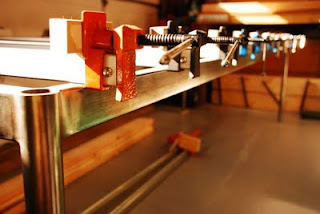
 A cool print from Brabant "the days last lesson"; makes trying to build a table that's bigger than your shop look like a walk in the park. I like it. Hand planing the western Maple door frames; what a pleasure planing something that actually fits on the bench.
A cool print from Brabant "the days last lesson"; makes trying to build a table that's bigger than your shop look like a walk in the park. I like it. Hand planing the western Maple door frames; what a pleasure planing something that actually fits on the bench.
The pleasure was heightened with the newly acquired Lie-Nielson No.62 low angle jack. what a sweet plane! Doing all that hand planing on the walnut gave me a chance to do some soul searching. While wooden planes are a beautiful thing, I've decided to reserve them for things like coopering or compass planes for now. Working in a garage has it's challenges, one being that I need to re-flatten the sole of wooden planes regularly, which opens the mouth. What i like about the bevel-up planes is you can easily change the angle of cut, depending on the angle of the micro bevel. With a bevel down wooden plane, you have to go make another plane with a different bed angle. I'm now using a honing guide & stop block jig to get repeatable micro bevels, and I also have a spare blade prepped with a steep angle for those difficult situations. The mouth on the bevel up planes is also adjustable, so it can be tightened up for fine shavings & less tear-out. I actually thought this plane was going to be on the first truck back to Lie-Nielson, it had a taper on the sole, so the leading edge of the iron was not parallel with the mouth. But I managed to lap it true in the end, & it seems to be running well. It's really like using a big block plane, very similar feel, I like it, I like it a lot.
I'm also really liking the Western Maple. One of my new favourites. It didn't machine that well, but it came to the party with hand planing & responds well to a good burnishing with the plane shavings. Nice to find a good local wood that's not too expensive (~$6/board foot). Hopefully Dan & I can harvest more soon.

















































